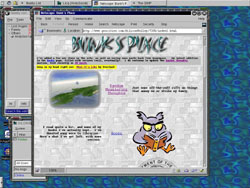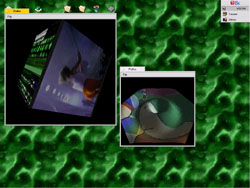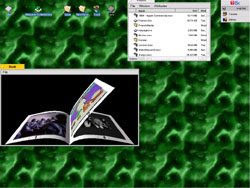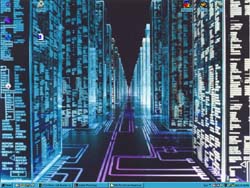Well, I’m going to break with my trend of complete incoherence and go for a set of Software Reviews today… I’ve recently had to do some reconstructive surgery on my computer, so I have new toys. I also did some experimenting, as long as I had to start over anyhow.
 So, although I’ve been very happy with Linux Mandrake for the past year or so, I thought I’d check out Caldera Open Linux, since they had a new version and I’d heard how simple it was to install. Changing into my "newbie" mode, I let it run the install as if I had no clue at all what Linux was. (Well, I did partition the HD, but if you bought the commercial version, it would do that for you too) WOW! It auto-ran from Windows, rebooted itself in DOS-Single mode, ran Loadlin, and started up a stripped-down version of X to install from. No more command line installations for newbies, no sir! OK, a GUI install is pretty, but how is the system? It gives you very few choices when you install the OS, kinda like Windows and unlike most Linux distributions. For most people, that’s good, since they will get less confused by the routine. In about 20 minutes (less than the Windows install I did the same week), I had Caldera Open Linux 2.3 installed and operational. It even recognized my wheel mouse and brand-new TNT2 video card. VERY nice install, and the system is set up for KDE as the desktop, which is good for most folks. Although many reviewers refer to KDE as Windows-like, I think of it more as CDE-like, but I’m familiar with Solaris, and most computer magazine writers apparently AREN’T.
So, although I’ve been very happy with Linux Mandrake for the past year or so, I thought I’d check out Caldera Open Linux, since they had a new version and I’d heard how simple it was to install. Changing into my "newbie" mode, I let it run the install as if I had no clue at all what Linux was. (Well, I did partition the HD, but if you bought the commercial version, it would do that for you too) WOW! It auto-ran from Windows, rebooted itself in DOS-Single mode, ran Loadlin, and started up a stripped-down version of X to install from. No more command line installations for newbies, no sir! OK, a GUI install is pretty, but how is the system? It gives you very few choices when you install the OS, kinda like Windows and unlike most Linux distributions. For most people, that’s good, since they will get less confused by the routine. In about 20 minutes (less than the Windows install I did the same week), I had Caldera Open Linux 2.3 installed and operational. It even recognized my wheel mouse and brand-new TNT2 video card. VERY nice install, and the system is set up for KDE as the desktop, which is good for most folks. Although many reviewers refer to KDE as Windows-like, I think of it more as CDE-like, but I’m familiar with Solaris, and most computer magazine writers apparently AREN’T.
 Another fun little doodad I installed recently was BeOS. The Be Operating System was originally designed to out-Mac the Macintosh, and was built for the PowerPC chips. Now, they have had a version out for Intel-compatible chips for a while. I ran its install and poked around a bit. Like Caldera, the Be install is also Windows-aware, and it auto-ran from the CD in
Another fun little doodad I installed recently was BeOS. The Be Operating System was originally designed to out-Mac the Macintosh, and was built for the PowerPC chips. Now, they have had a version out for Intel-compatible chips for a while. I ran its install and poked around a bit. Like Caldera, the Be install is also Windows-aware, and it auto-ran from the CD in  Windows, starting a DOS-mode install and setting up its environment. When it rebooted, it ran Partition Magic Special Edition, created its partition from freespace on the HD, rebooted into the Be install, and installed itself with nearly no interaction from me. In fact, there is almost nothing to decide on during the install, other than which partition to set up on. After it installed, I ran some of the demos, and tried to get online. *BUZZ* Can’t do it. Although Be’s web site claims that my ethernet card is supported, it did not recognize it, even after repeated attempts to make it go. So, it’s off my hard drive again. Maybe next year. The pictures I’ve posted show some of Be’s out-of-the-box demos. The images are NOT stills, they are animated and lighted in real-time, while showing multiple video images and real-time deformation. If you’re a graphics geek, you just said, "cool!" and the rest of you said, "huh?"
Windows, starting a DOS-mode install and setting up its environment. When it rebooted, it ran Partition Magic Special Edition, created its partition from freespace on the HD, rebooted into the Be install, and installed itself with nearly no interaction from me. In fact, there is almost nothing to decide on during the install, other than which partition to set up on. After it installed, I ran some of the demos, and tried to get online. *BUZZ* Can’t do it. Although Be’s web site claims that my ethernet card is supported, it did not recognize it, even after repeated attempts to make it go. So, it’s off my hard drive again. Maybe next year. The pictures I’ve posted show some of Be’s out-of-the-box demos. The images are NOT stills, they are animated and lighted in real-time, while showing multiple video images and real-time deformation. If you’re a graphics geek, you just said, "cool!" and the rest of you said, "huh?"
Some thoughts in comparison between Windows, Linux, and Be:
| Operating System | Installation time | Boot time | Gotchas/summary |
| Windows 98 SE | 3 hours, including futzing around to make it recognize all of my peripherals simultaneously. | 115 seconds (with my Startup group disabled) | Supported by most software makers, but crashes WAY too much. I have to watch my resources like a hawk or the darned thing locks up on me. UDMA is supposed to work, but hangs my system 10% of the time, and it takes forever to startup and shutdown. |
| Caldera Open Linux 2.3 | 35 minutes, including the time waiting for Windows to reboot. | 63 seconds, to a usable GUI desktop after logging in. | Not too much software available off-the-shelf, but plenty available online and in book stores, etc. Great for heavy use, but not really a good game platform yet (except for Loki games). No decent Access-equivalent, but the rest of Office functions are available from StarDivision. |
| Linux Mandrake 6.1 | 40 minutes, mainly because I chose to select individual packages | 73 seconds (more daemons loaded than I need) | Same as Caldera, but Mandrake is better supported by "the community" since it has the same directory structure as Redhat, and Caldera is a little different. |
| BeOS 4.5 | 21 minutes, including Windows rebooting and re-partitioning the HD. | 19 seconds (WOW!) | Quite nearly no software support, with the exception of Macromedia’s promised support. Amazingly fast and flexible system, and based on Unix, so pretty darned secure and stable. |
So, the final verdict is pretty ambivalent. All the OS’s have pluses and minuses, depending on what you want to do with them. Personally, I’m running a dual-boot system. I nuked Be, moved back to Mandrake instead of OpenLinux, and I spend most of my time in Windows. I’d like to spend more time in Linux, but the Gimp is not as friendly to me as Photoshop, I don’t know of a decent HTML WYSIWYG editor, and game support is kinda paltry. But, as soon as I can, I’ll jump to a stable OS, whoever makes it.


 Previous
Previous  Next
Next 



 Categories
Categories Tag Cloud
Tag Cloud Blog RSS
Blog RSS Comments RSS
Comments RSS
 Last 50 Posts
Last 50 Posts Back
Back Void
Void  Life
Life  Earth
Earth  Wind
Wind  Water
Water  Fire
Fire